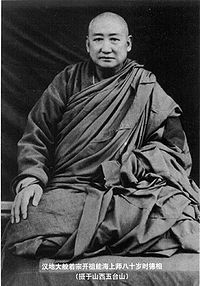Views
Nénghǎi 能海 (1886-1967)
|
| Notable Associates: |
|
Nénghǎi 能海 (1886-1967) was one of the most significant Chinese exponents of Tibetan Esoteric Buddhism 西密 in 20th century China.
Contents |
Biography
Nénghǎi began his education in a traditional academy. In 1904 (Guāngxù 30) he tested into a military school in Sìchuān 四川. After completing his studies he worked in the military for several years. From 1909 to 1910 he taught at a military school in Yúnnán 雲南 before returning to Sìchuān. After the revolution of 1911 he was stationed in Chéngdū 成都.
In 1913, Nénghǎi's friend took him to see the Venerable Fóyuán 佛源 lecture on the Buddhist scriptures. Nénghǎi took refuge under Fóyuán and became a devout Buddhist. The following year, Nénghǎi took leave from the military and traveled to Běijīng 北京. There he met the famous Buddhist layman Zhāng Kèchéng 張克誠, who was from the same town as him. Nénghǎi began studying Consciousness-Only 唯識 under Zhāng at Guǎngjì Temple 廣濟寺. In Běijīng he also had the opportunity to study Esoteric Buddhism at the Yōnghé Temple 雍和宮. This experience would have a profound impact on the rest of his life.
In Běijīng, Nénghǎi decided to become a monk, but he had to wait until his wife had had a child. He returned to Sìchuān. In Sìchuān, Nénghǎi attended lectures at a local Buddhist study society. When his wife had a baby, Nénghǎi went to Tiānbǎo Temple 天寶寺 in Chóngqìng 重慶 where he was tonsured under Fóyuán in 1924. He received full ordination under Guànyī 貫一 at Bǎoguāng Temple 寶光寺 the following year.
After his ordination, Nénghǎi read about the Residing-in-Tibet Dharma Studies Group 留藏學法團 organized by Dàyǒng 大勇 and he made his mind up to travel to Tibet to study Tibetan Esoteric Buddhism 西密. In February of 1926, he and several of his ordination brothers traveled to Kham. There they studied Tibetan language under ?降巴格尊者, who gave Nénghǎi the Tibetan name ?雲登嘉措. After a little over a month Nénghǎi was force to move along after a local official became suspicious of him after he heard about Nénghǎi's military background.
Nénghǎi went onward, and studied with ?雜哇 Geshe. In October of 1926, he heard about the death of his master Fóyuán and began the return trip. On his way back he met Dàyǒng and his group in Kāngdìng County 康定縣. Dàyǒng asked him to stay and continue his studies, and he did. There, the group received instruction in various rites of Tibetan Buddhism, as well as continuing their language studies.
At the beginning of 1927, he and Yǒngguāng 永光 traveled to another temple and received further instruction and initiation. After getting a letter of introduction to Khangsa Rinpoche in Lhasa, Yǒngguāng and Nénghǎi returned to Chéngdū in the winter of 1927 in order to prepare for the trip to Tibet's capital.
They set out on June 20, 1928 with a great deal of provisions and two other monks. Along they way they visited Dàyǒng in Garzê 甘孜 province. They battled harsh weather but finally made it to Lhasa on September 20, 1928, three months after they had left Chéngdū. In Lhasa, they met with Khangsa Rinpoche. Nénghǎi became the Rinpoche's disciple and received abhiṣeka 灌頂 from him, as well as dharma transmission, which made him a 28th-generation lineage holder in Tsongkhapa's line. Nénghǎi returned to Sìchuān in the winter of 1932 to secure more funds, but came back to Lhasa. He formally returned to Sìchuān in 1933.
After his return, he traveled to various places, including Wǔtáishān 五台山, Shànghǎi 上海, and Jiāngxī 江西. At these places he lectured on Tibetan scriptures and performed ceremonies. When the Second Sino-Japanese War broke out in 1937, he took his disciples from Wǔtáishān and returned to Sìchuān.
| This section is incomplete and more content needs to be added. You can help by contributing text, images, or suggestions. |
MORE TO BE ADDED HERE
After the Red Guards attacked Mt. Wǔtái 五台山 in 1966, the temples were dismantled, but Nénghǎi remained. He died in meditation on February 9, 1967.
Notable Students
Notes
References
- Bianchi, Ester. "L'insegnamento tantrico del 'lama cinese' Nenghai (1886-1967). Inquadramen to storico e analisi testuale del corpus di Yamāntaka-Vajrabhairava." Ph.D. disst. Università Ca'Foscari di Venezia - Ecole des Hautes Etudes en Sciences Religieuses, 2003.
- Tuttle, Gray. Tibetan Buddhism in the Making of Modern China. New York: Columbia University Press, 2005. Pp. 97-98, and passim.
- Yú Língbō 于凌波, ed. Xiàndài Fójiào rénwù cídiǎn 現代佛教人物辭典 (A Dictionary of Modern Buddhist Persons), 2 vols. Taipei: Foguang, 2004. Pp. 1.897b-901a.
